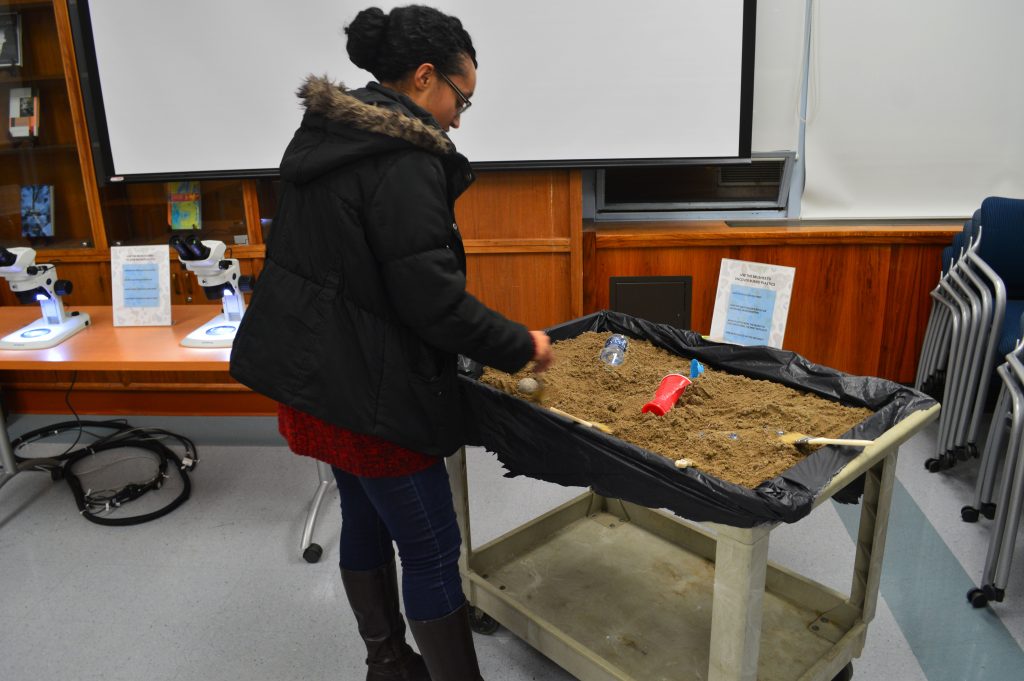
Vestal, New York and the Galapagos Islands have more in common than meets the eye.
In both locations, marine pollution is a major issue. Ben McLauchlin, a senior double-majoring in graphic design and environmental studies, is using art to shed light on the issue.
“Unnatural Selection,” an interactive art exhibition at Binghamton University, displays the threat of plastic to marine organisms — and humans — all over the world.
The exhibition features posters with facts, holographic images of seafood, plastic optical illusions and plastic sea animal sculptures.
“[Plastic] was a very different medium for me to work in,” McLauchlin said. “I had never worked with plastics before this and being able to go around Binghamton and pick up trash and revitalize it was really rewarding. It was a very unique process in terms of manipulating the materials and creating the different shapes that you see in the exhibit.”
According to Dyllan May, a sophomore majoring in biology, using art as a method of study can help science amateurs grapple with these current environmental problems.
“It’s really inspirational and he’s so creative,” said May. “This whole idea about teaching people about science through art — I think it’s kind of revolutionary.”
McLauchlin said his interest in marine pollution began in the summer of 2016 during his study abroad program in the Galapagos Islands, where he participated in a marine biology lab. In spring of 2017, McLauchlin started brainstorming for this project and began to build the art pieces the following summer with funding by the Binghamton University Summer Scholars & Artists Fellowship 2017 Program. He also had help from Francis Chang, lecturer for the department of Art and Design, and Jessica Hua, assistant professor of biological sciences.
This is not McLauchlin’s first venture into this kind of project. Previously, he had curated other exhibitions to highlight similar issues of marine pollution, but his use of plastic as a medium makes this one unique.
Having guidance from academics and professionals in both science and art allowed McLauchlin to bring the dense concepts to a wider audience. Corinne Fischer, who worked with McLauchlin in the lab and is a junior double-majoring in environmental studies and geography, said this exhibition made the subject more digestible.
“A lot of people think [water pollution] doesn’t involve them,” she said. “[The exhibition] helps people realize it affects everyone and anyone can learn about it.”
According to the exhibition, 75 percent of marine debris is plastic and $13 billion of natural capital like water, soil and living organisms are lost annually because of plastic pollution.
“I’ve always been fascinated by [garbage] in particular,” McLauchlin said. “I was perplexed that there could be so much trash in the ocean and I wanted to learn more about it.”
He also highlights the domino effect this pollution has on animals and humans. The toxic chemicals from plastic are ingested by animals, which are then transferred to humans after consuming seafood.
The goal of McLauchlin’s work is to demonstrate the harsh reality of marine pollution and its effects on the environment through demonstrating that the issues rest not only in the Galapagos Islands, but also in the backyard of the Binghamton area.
“I hope that [people] gain appreciation for how fragile the ecosystems are here and abroad,” McLauchlin said. “And I hope that they leave with more knowledge and an interest combining plastic pollution in their own lives.”
For Brittney Pemberton, a junior double-majoring in human development and psychology, McLaughlin’s artwork did just that.
“It helps people like me who are more visual,” she said. “Sometimes they need to see something and it kind of sticks with you a little bit more. Before, I wasn’t thinking about [plastic pollution] but now this has kind of been brought to the forefront of my mind.”
The free exhibition debuted Wednesday night in the Institute for Advanced Studies in the Humanities Conference Room in Glenn G. Bartle Library. It will be open Nov. 9 from 5 p.m. to 8 p.m. and Nov. 10, from 9 a.m. to 11 a.m.


